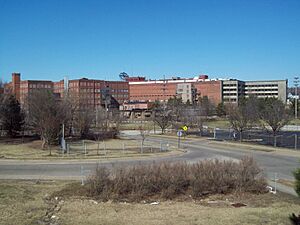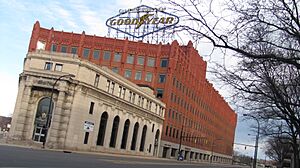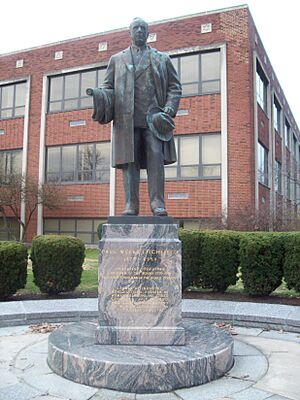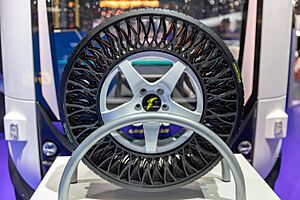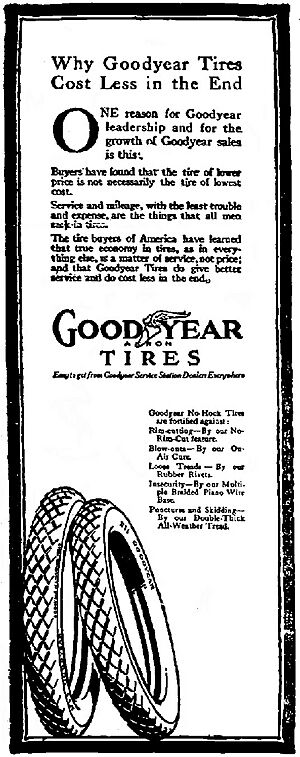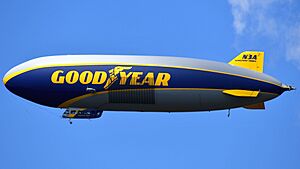Goodyear Tire and Rubber Company facts for kids
Logo used since 1968
|
|
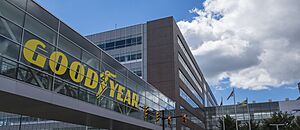
The company's headquarters in Akron, Ohio
|
|
| Public | |
| Traded as |
NYSE: GT (1927-2012) DJIA component (until 1999) S&P 500 component (1957-2019) |
| Industry | Manufacturing |
| Founded | August 29, 1898 Akron, Ohio, U.S. |
| Founder | Frank Seiberling |
| Headquarters |
Akron, Ohio
,
U.S.
|
|
Number of locations
|
1,240 tire and auto service centers 57 facilities |
|
Area served
|
Worldwide |
|
Key people
|
Mark Stewart (chairman, president, and CEO) |
| Products | Tires |
| Revenue | |
|
Operating income
|
|
| Total assets | |
| Total equity | |
|
Number of employees
|
68,000 (2024) |
| Subsidiaries | List of subsidiaries |
The Goodyear Tire & Rubber Company is a big American company that makes tires. Its main office is in Akron, Ohio. Goodyear makes tires for many different vehicles. These include cars, airplanes, trucks, motorcycles, and even race cars. They also make tires for heavy machines used off-road.
Goodyear also lets other companies use its brand name for bicycle tires. They stopped making bicycle tires for a while but started again in 2015. As of 2017, Goodyear was one of the top five tire makers in the world. Other big tire companies are Bridgestone from Japan and Michelin from France.
The company started in 1898. It was founded by Frank Seiberling. He named it after Charles Goodyear, who invented "vulcanized" rubber. This special rubber is stronger and more useful. The first Goodyear tires were popular because they were easy to take off and didn't need much care.
Goodyear has made airships and balloons since the early 1900s. The first Goodyear Blimp flew in 1925. Today, these blimps are famous advertising symbols in America. Goodyear is also the only tire supplier for NASCAR races. They have won more races and championships in Formula One than any other tire company. Goodyear stopped supplying tires for Formula One after the 1998 season.
Goodyear was the first global tire company to open a factory in China. This happened in 1994 in Dalian. Goodyear was also part of the Dow Jones Industrial Average, a group of important companies, from 1930 to 1999. In 2013, the company opened a new main office building in Akron.
Contents
Goodyear's Early Days
How It Started: 1898–1926
The first Goodyear factory opened in Akron, Ohio, in 1898. At first, the company made tires for bicycles and carriages. They also made rubber pads for horseshoes and even poker chips. As cars became popular, Goodyear grew quickly.
In 1901, Goodyear's founder, Frank Seiberling, made racing tires for Henry Ford. In 1903, Paul Weeks Litchfield, who later became a leader at Goodyear, got a patent for the first tubeless car tire. In 1910, Goodyear bought a rubber factory in Canada. This was their first factory outside the United States.
In 1916, Litchfield found land in Arizona that was good for growing cotton. This special cotton was needed to make rubber stronger for tires. Goodyear bought 36,000 acres of land. This land later became the towns of Goodyear and Litchfield Park.
In 1924, Litchfield worked with a German company called Luftschiffbau Zeppelin. They formed the Goodyear-Zeppelin Corporation. From the late 1920s to 1940, they built two Zeppelins in the United States. This partnership continued until World War II began.
Growing Bigger: 1926–1970
On August 5, 1927, Goodyear offered its shares to the public for the first time. Its shares were listed on the New York Stock Exchange.
By 1930, Goodyear had created special "tundra tires" for small airplanes. These tires were big and had low air pressure. They were called "airwheels."
Over the next few decades, Goodyear became a huge company around the world. They bought a rival company, Kelly-Springfield Tire, in 1935. During World War II, Goodyear made F4U Corsair fighter planes for the U.S. military. The partnership with Zeppelin ended in December 1940 because of the war. By 1956, Goodyear also owned and ran a nuclear processing plant in Ohio.
In 1944, Goodyear started a new company in Mexico with a local partner. It was called Compañía Hulera Goodyear-Oxo.
The Shift to Radial Tires
Goodyear is the only one of the five biggest U.S. tire companies from 1970 that is still independent today. This is partly because of a big change in tire technology: the move to radial tires. Before, most tires were "bias-ply" tires. Radial tires were better, but factories needed expensive new machines to make them.
In 1968, Consumer Reports, a well-known American magazine, said that radial tires were much better. Michelin had developed these tires in 1946.
When Charles J. Pilliod Jr. became CEO in 1974, he had to decide whether to invest a lot of money in making radial tires. Even though some people disagreed, Pilliod invested heavily in new factories and tools. Today, almost all tires are radial tires. Sam Gibara, who led Goodyear later, said that without Pilliod's decision, Goodyear "wouldn't be around today."
Goodyear's sales reached $3 billion in 1969. Five years later, sales were over $5 billion, and Goodyear had operations in 34 countries. In 1978, the original factory in Akron became a Technical Center for research and design. By 1985, sales around the world were more than $10 billion.
Goodyear also had a part of its company called Goodyear Aerospace. This part designed a supercomputer for NASA in 1979. Goodyear Aerospace was sold in 1987.
In 1987, Goodyear started working with a Canadian tire store called Fountain Tire.
Changes and Focus on Tires
In the 1980s, Goodyear's CEO, Robert E. Mercer, thought the tire business was growing too slowly. He wanted the company to buy businesses that were not related to tires.
In 1983, Goodyear bought a natural gas company called Celeron Corporation. They also invested a lot in finding gas, including building a 1,200-mile oil pipeline from California to Texas.
In 1986, a British investor named James Goldsmith bought a large part of Goodyear's stock. He thought the company should sell its oil businesses and focus on tires. Goodyear bought back all of Goldsmith's shares and many other shares from other investors.
Because of this, Goodyear made big changes. They sold Goodyear Aerospace and their motor wheel business. They also sold other businesses, including the Celeron gas and oil company. By 1998, they had mostly sold off the businesses that Goldsmith had suggested. After 1987, Goodyear invested more in its tire business. New leaders helped modernize and expand Goodyear factories. However, in the 2000s, some plants in North America closed as the company moved business to countries with lower costs.
From 1990 to Today
The company had another big change in 1991. Goodyear hired Stanley Gault to help the company grow into new areas. About 12,000 employees were laid off during this time.
In 2005, Titan Tire bought Goodyear's farm tire business. Titan now makes Goodyear agricultural tires under a special agreement.
In 2009, Goodyear announced it would close its tire plant in the Philippines. This was part of a plan to make their manufacturing more efficient around the world.
Goodyear also planned to sell its off-road tire business in Latin America to Titan Tire. This included a factory in São Paulo, Brazil. Titan would also be allowed to keep making tires under the Goodyear brand.
In 2011, Goodyear announced they would work with Zeppelin again. This was more than 70 years after their first partnership ended during World War II. They planned to build more zeppelins together.
In 2018, Goodyear and Bridgestone started a joint company called TireHub. This company helps distribute tires across the United States. At the same time, Goodyear ended its distribution agreement with American Tire Distributors.
In December 2018, Goodyear stopped working in Venezuela. This was because of a lack of materials and rising costs.
In February 2021, Goodyear announced it would buy the Cooper Tire & Rubber Company for $2.5 billion. This deal was completed in the second half of 2021.
Important Dates
Here are some key moments in Goodyear's history:
- 1898: Goodyear is founded.
- 1899: Automobile tires are added to their products.
- 1901: Frank Seiberling makes racing tires for Henry Ford.
- 1903: Paul Litchfield gets a patent for the first tubeless car tire.
- 1908: Ford's Model T cars use Goodyear tires.
- 1909: The first airplane tire that uses air is made.
- 1911: The first airship envelope is created.
- 1912: The Goodyear blimp first appears.
- 1917: Goodyear makes airships and balloons for the U.S. military during World War I.
- 1919: Tires on the winning car at the Indianapolis 500 are Goodyear tires.
- 1924: Goodyear and Zeppelin form a joint company.
- 1925: The Pilgrim, the first commercial airship to use helium, is launched.
- 1926: Goodyear becomes the world's largest rubber company by sales.
- 1927: Goodyear's shares are first sold to the public.
- 1929: Construction begins on the world's largest airship dock in Akron.
- 1935: Goodyear buys Kelly-Springfield Tire.
- 1937: The first American-made synthetic rubber tire is created.
- 1940: The Goodyear-Zeppelin partnership ends due to WWII.
- 1942: Goodyear gets a contract to build Corsair naval fighter planes.
- 1947: The first nylon tires are developed.
- 1949: Goodyear starts its first television advertising.
- 1957: The Goodyear Proving Grounds for tire testing are rebuilt.
- 1963: Goodyear produces its one billionth tire.
- 1965: Radial-ply tires become available for car makers.
- 1967: Goodyear introduces the Polyglas tire.
- 1969: Sales reach $3 billion.
- 1970: Goodyear tires are the first tires on the moon (Apollo 14).
- 1974: Sales reach $5 billion.
- 1975: Goodyear supplies all tires for the Indianapolis 500.
- 1977: The first all-season tire (Tiempo) is introduced.
- 1978: The Akron plant becomes a Technical Center for research.
- 1983: The three billionth tire is produced.
- 1984: Worldwide sales go over $10 billion.
- 1987: The California–Texas "All American" oil pipeline is finished.
- 1991: The Aquatred tire is introduced.
- 1993: Goodyear opens its first tire store in Beijing, China.
- 1994: The Dalian plant in China opens.
- 1995: Worldwide sales go over $13 billion.
- 1998: Goodyear sells its All American Pipeline and Celeron businesses.
- 1999: Goodyear forms a big partnership with Japan's Sumitomo Rubber Industries.
- 2005: North American farm tire operations are sold to Titan Tire Corporation.
- 2006: The Goodyear blimp makes its first trip in China.
- 2009: The Goodyear Assurance Fuel Max tire is introduced.
- 2011: Goodyear and Zeppelin's company partner again to build more airships.
- 2013: A new headquarters building opens in Akron.
- 2015: Goodyear and Sumitomo end their worldwide partnership.
- 2018: Goodyear is ranked 187th on the Fortune 500 list of largest U.S. companies.
- 2021: Goodyear buys the Cooper Tire & Rubber Company.
Goodyear's Brands
Goodyear owns several other tire brands. These include:
- Cooper Tire & Rubber Co.
- Dunlop Tyres (in North America, Europe, Australia, and New Zealand)
- The Kelly Springfield Tire Company (in the United States)
- Douglas Tires
- Fierce
- Lee
- Sava (in Slovenia)
- Fulda (in Germany)
- Dębica (in Poland)
- Wingfoot Commercial Tire Systems, LLC
- Bluestreak (in Indonesia)
- Regetta (in Australia)
- LS2000 (in Japan)
- Goodyear Auto Service Centers
- Goodyear Chemical
- Just Tires
- Raben Tire
Goodyear Blimps
The Goodyear Blimps are a group of airships. They are mostly used for advertising and to film live sports events for television. The Pilgrim, in 1925, was the first Goodyear blimp used for advertising.
Starting in 2014, Goodyear began to replace its older blimps with newer Zeppelin NT models. Wingfoot One, the first new Zeppelin in Goodyear's U.S. fleet, was named on August 23, 2014. It is based near Akron, Ohio. The Goodyear blimp fleet now includes Wingfoot One (in Florida), Wingfoot Two (in California), and Wingfoot Three (in Ohio).
Leadership
Presidents of Goodyear
- D. E. Holl, 1898–1899
- R. C. Penfield, 1899–1903
- L. C. Miles, 1903–1906
- Frank A. Seiberling, 1906–1921
- E. G. Wilmer, 1921–1923
- G. M. Stadelman, 1923–1926
- Paul W. Litchfield, 1926–1940
- Edwin J. Thomas, 1940–1958
- Russell DeYoung, 1958–1971
- Victor Holt Jr., 1971–1972
- Charles J. Pilliod Jr., 1972–1974
- John H. Gerstenmaier, 1974–1978
- Robert E. Mercer, 1978–1982
- Tom H. Barrett, 1982–
Chairmen of the Board
- Paul W. Litchfield, 1930–1958
- E. J. Thomas, 1958–1964
- Russell DeYoung, 1964–1974
- Charles J. Pilliod Jr., 1974–1983
- Robert E. Mercer, 1983–
See also
 In Spanish: Goodyear para niños
In Spanish: Goodyear para niños
- List of tire companies
- NASCAR Canadian Tire Series


